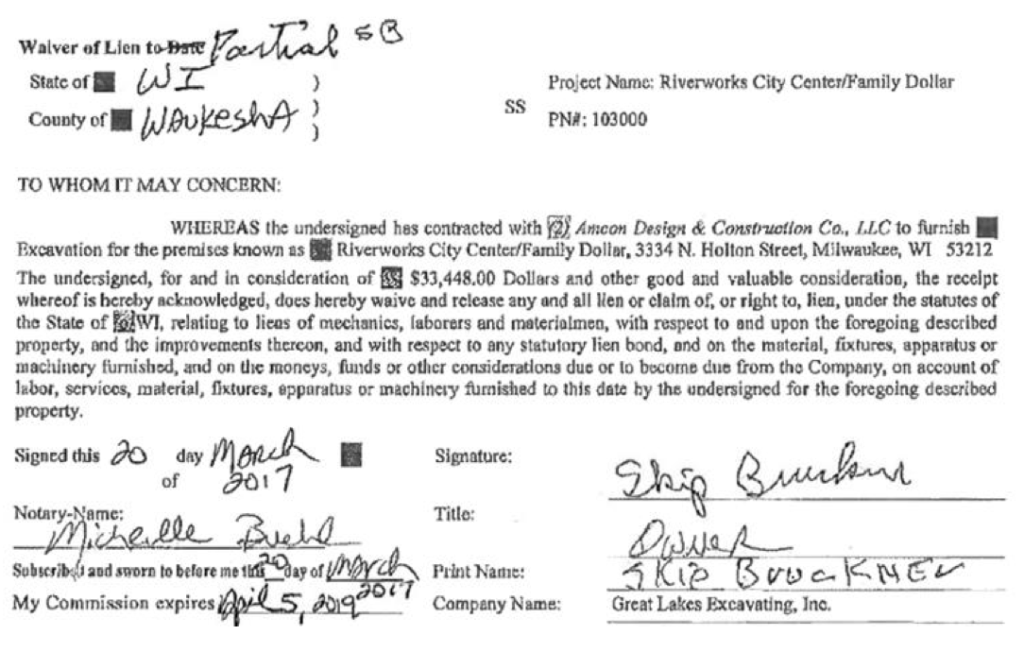
The execution and exchange of lien waivers is an essential element of the construction payment process. However, these documents are frequently overlooked and not given the proper attention they deserve. Far too often, these documents are signed and sent without fully understanding the terms and the potential consequences. Unfortunately, this mistake recently cost a Wisconsin subcontractor over $180,000 worth of lien rights — when they only intended to waive around $33,000.
Wisconsin lien waiver rules
A handful of states (12 to be exact) offer a form that waivers must (or should) use to effectively waive lien rights. In states where these lien waiver forms are unregulated, careful attention should be paid to the form itself.
Wisconsin falls into this category. This, however, doesn’t mean that waivers are completely unregulated. The statutes governing the efficacy of lien waivers in Wisconsin can be found under Wis. Stat. §779.05(1):
“…any waiver document shall be deemed to waive all lien rights of the signer for all labor, services, materials, plans, or specifications performed, furnished, or procured, or to be performed, furnished, or procured, by the claimant at any time for the improvement to which the waiver relates, except to the extent that the document specifically and expressly limits the waiver to apply to a particular portion…”
Thus, in Wisconsin, the parties are free to use any lien waiver form they choose. Plus, that waiver is presumed to be a full and final lien waiver unless the document expressly limits the waiver to a certain amount or through date.
A recent Wisconsin Court of Appeals decision highlighted how strictly enforced these rules are, as they declared that a subcontractor waived all of their lien rights by failing to expressly limit the waiver.
Sub inadvertently executes a final lien waiver
The case in question is Great Lakes Excavating, Inc. v. Dollar Tree Stores, Inc.
Project Snapshot:
- Property Owner: Riverworks City Center, LLC (Riverworks)
- Represented by: Steven J. Swalinski & Paul W. Zimmer of O’Neil Cannon Hollman DeJong & Laing, S.C.
- General Contractor: AMCON Design and Construction, Co., LLC (AMCON)
- Subcontractor: Great Lakes Excavating, Inc. (Great Lakes)
- Represented by: John E Machulak of Machulak Robertson & Sodos, S.C.
AMCON was the general contractor on a project for the construction of a commercial building and a parking lot. Great Lakes was hired by AMCON to perform work related to the parking lot portion of the project.
A few change orders later, the project neared completion, and Great Lakes submitted an invoice for $222,238. After failing to receive payment, Great Lakes reached out to AMCON who stated that all they could currently pay was $33,448 of the remaining balance.
Subcontractor handwrites changes to make the waiver “partial”
AMCON provided Great Lakes with a document entitled “Waiver of Lien to Date.”
According to Great Lakes, AMCON stated that they were only required a partial waiver in exchange for payment. So Great Lakes crossed out the words “to Date,” wrote in “Partial,” and signed the waiver. In return, AMCON provided them a check for $33,448.

When additional payments weren’t made, Great Lakes filed a Wisconsin mechanics lien in the amount of $188,790 ($222,238 minus the $33,448 paid) and subsequently initiated a foreclosure action.
Riverworks moved for partial summary judgment on the grounds that Great Lakes had waived all of its lien rights because it did not expressly limit the waiver to a particular portion of the work, pursuant to the procedure set forth in Wis. Stat. §779.05(1).
Circuit court granted the motion, and Great Lakes appealed.
Headers and titles don’t matter as much as the substance of the waiver
The Appeals Court began by stating that although the parties intended to limit the waiver to a partial waiver, this was done improperly. The statute governing waivers explicitly requires that the document must “specifically and expressly limit the waiver” to apply to a particular portion of such labor, services, materials, plans, or specifications.”
Simply changing the title of the lien waiver, without any additional explanation does not “specifically and expressly” limit the waiver. Furthermore, although the waiver included the amount of $33,488, the rest of the document stated the “for and in consideration of $33,488 Dollars… does hereby waive and release any and all lien… furnished to this date.” That statement alone, was enough for the courts to conclude that:
“The lien waiver document here constituted a waiver of Great Lake’s lien rights. Great Lakes failed to properly limit its lien pursuant to Wis. Stat. §779.05(1). Although lien law is generally construed liberally, we will not disregard a statute that is clear on its face.”
Wisconsin construction attorney weighs in
We reached out to Paul Zimmer, a Wisconsin construction attorney who represented Riverworks on this case.
“In our view, this case involved a straightforward application of an unambiguous statute, which required the contractor to clearly specify any lien rights not being waived,” Zimmer said.
“The contractor did not specify any lien rights not being waived, so the court of appeals, like the trial court, was correct to conclude that the contractor waived all of its lien rights in its written lien waiver.”
Review the terms of your lien waiver carefully
Although having to use certain statutory forms in certain states seems burdensome, it has the contractor’s best interests in mind.
With a predetermined waiver form, parties don’t need to worry about additional rights or amounts being waived or run into situations such as this. All lien waivers should be treated with care, and the waiving party should be very specific regarding the scope of work and amount of lien rights covered under the waiver.
Making quick edits to a waiver form by crossing out and adding in something different is a dangerous proposition — particularly a header or document title.
Had Great Lakes reviewed the language, they would have noticed that the waiver waived all lien rights “to date” regardless of the document’s title or the actual intent of the parties — a lesson that any contractor working in Wisconsin should keep in mind.
Granted, at the end of the day, Great Lakes still has the ability to seek recovery under breach of contract and other claims, but they mistakenly gave up their best leverage: lien rights.
For a deep dive on the subject, see: Should I Sign That Lien Waiver? Checklist & FAQs